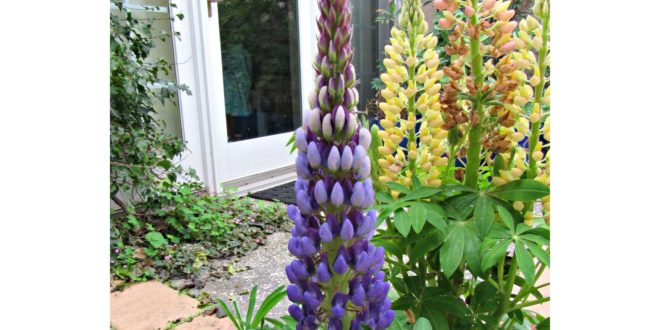New to our Sunnyvale garden in 2019 are lupines. They are spectacular in the garden and in the nature.
Choose a sunny site with average, well-draining soil. Lupines are legumes and can improve a soil’s fertility over time.
Light: Full sun is preferred. Lupine can grow in part shade, but flowering will be lessened.
Soil: Lupine needs well-draining soil above all else. It prefers soil on the acid side and will not tolerate high levels of alkalinity or water-logged conditions. Russell hybrids and L. polyphyllus have more tolerance for moist conditions than many other species, but none are lovers of high heat or humidity.
Spacing: If broadcasting seed, broadcast at a rate of approximately 1 pound per 1000 feet. If planting mature plants, space larger varieties 2-3’ apart, smaller varieties 12-18” apart.
Lupines are deep rooted and do not spread except through re-seeding. Seeds will not come true to the original variety planted, but will eventually revert to blue-violet and white.
Planting:
The most important thing to note before planting Lupines, is that they are available as both annuals and perennials. While Lupine seeds may yield both annual (life cycle complete in one growing season) and perennial (long-lived, coming back each spring) varieties, potted Lupine plants are typically perennial cultivars.
For plants: Upon delivery in early spring, plant immediately in a hole that has been amended with organic matter and grit for good drainage. Do not allow mulch or other organic matter to touch the crown of the plant and induce rot. Water in thoroughly.
For seeds: Lupine seeds can be planted in very early spring, but tend to do better if planted in late spring and allowed to overwinter, blooming in the following spring like foxgloves. They have a very tough seed coat, and it’s a good idea to either soak seeds for 24-48 hours, or roughen them between two sheets of sandpaper before planting. Cover lightly with soil (1/8”) and tamp down the seeds well – making sure they make good soil to seed contact. Water in, and if the weather is dry, water lightly until germination which can take up to 10 days.
How to Grow Lupine Throughout the Season
Growth Habit: Lupine has a rounded shrub-like habit and grows from 12-48” high depending on species or variety. Individual flowers resemble those of peas and are densely packed on several spikes above the foliage.
Staking: For Russell hybrids and taller species, it is wise to stake flower spikes if you have the time. Though they stand very straight on their own, high winds can blow the flower spikes over and create a curve in the flower as it attempts to grow back towards the sun. Smaller wildflower species do not need staking.
Watering: For the first few months in your garden, make sure that lupine plants are getting adequate water for good root development (they are deeply rooted), but let the soil dry out between waterings. After that, water only during periods of drought or very dry spells.
Fertilizing: Extra fertilizing is not necessary, but a top dressing of compost is appreciated, as long as it isn’t placed close to the crown of the plant.
Mulching: A light dressing of mulch is not a bad idea, particularly in hotter climates, but it is crucial that mulch is not allowed to touch the crown of the plant and induce stem rot.
Trimming & Pruning: Lupine can bloom again lightly on side shoots if immediately deadheaded. If seeds have begun to form in the lower parts of the flower however, they are unlikely to repeat their bloom.
After blooming, the foliage is not as attractive in the garden and can often suffer from mildew. As cutting it back completely can kill or weaken the plant, many gardeners choose to remove the plants completely and grow lupine as biennials, placing out new spring-grown plants in the fall for the next season. This is especially true in the southern limits of its heat hardiness where humidity is punishing.
Companion Plants: Wildflower species of lupine, such as L. perennis or L. texensis look absolutely magnificent carpeting a meadow, or planted in conjunction with another early summer wildflower like California poppy or Indian paintbrush.
One of the most striking combinations seen with garden lupines (Russell hybrids and large species) is planting tulip bulbs with lupine starts in the fall. By spring, the lupine foliage is developing nicely and providing a beautiful backdrop for the tulips. Once the tulips have bloomed well, the lupines are right behind, showcased by their own foliage.
Lupines are a terrific plant for cottage gardens and pair nicely with old favorites like allium, globe thistle and phlox. As hybrids come in so many colors, the combinations are endless.
Additional Uses: Lupines are a deer resistant plant and make a great addition to a landscape plagued by four-footed pruners. They attract bees and butterflies of all sorts with their multi- and bi-colored flowers, and are a great choice for pollinator gardens.
Lupines are a legume, and in symbiosis with a soil bacteria, are able to fix airborne nitrogen in soil into usable nodules on roots that can enrich the soil – especially if turned under as a green manure. Intensively planting lupine can increase a soil’s fertility.








